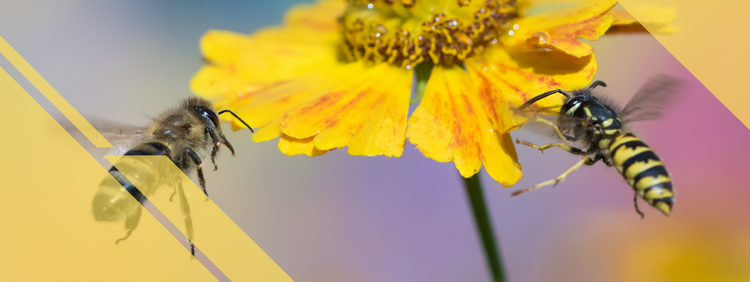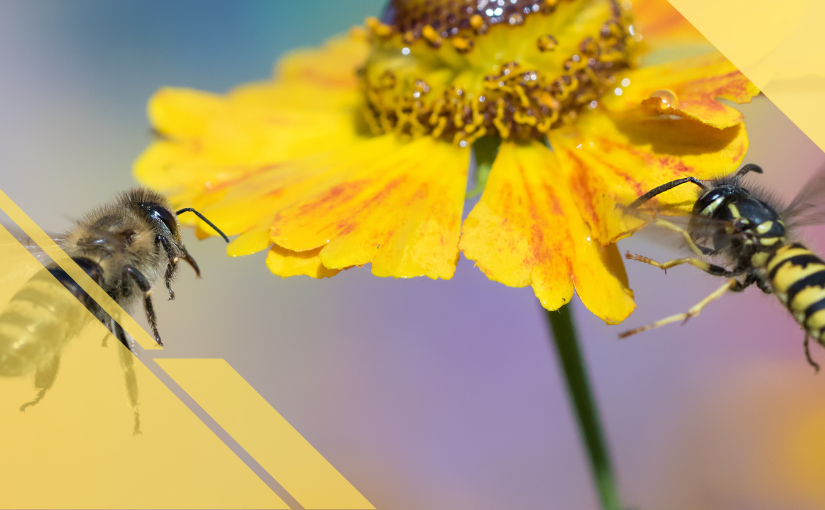
Bees and wasps look similar but behave very differently. Knowing the differences can keep you from a painful experience and help you communicate with exterminators. According to experts in bee pest control in Toronto, the major differences between bees and wasps are their colour, size, stingers and nests.
Colour
Wasps and bees have similar colouring, so it’s easy to confuse them with a quick glance. Both are black and yellow, but the patterns vary, as does the body texture.
As residential pest control experts point out, yellow jackets and paper wasps (two of the most common types) have yellow and black stripes or spots, giving them the appearance of carpenter bees. However, their yellow legs are a stark warning that this is no honey-maker.
Both carpenter and honey bees have black legs. Carpenter bees may be yellow and black or entirely black, while their honey cousins sport the traditional yellow-and-black stripes. Both have a rounded thorax and abdomen, giving them a plump appearance. However, carpenter species have smooth bodies, while honeybees possess tiny hairs perfect for collecting pollen.
Wasps have a more slender appearance, and their thoraxes taper into the abdomen. Their abdomens may be larger than their thoraxes, and they never possess hair.
Size
If you can tell an insect’s species by the colour, you’re probably too close. It’s much easier to judge size from a distance. While the difference between wasps and honeybees is physically small, it’s significant enough that home pest control teams can identify the culprit with a brief description.
Wasps are typically three-quarters of an inch long, approximately the diameter of a nickel. Bees are smaller at half an inch — about the size of the plastic top on a thumbtack.
Stingers
Both wasps and bees have stingers, though if you can tell the difference, you should seek medical attention. Of course, it’s still important to know the difference, the most obvious of which is how often one insect can sting.
A single bee can only sting once because the stinger breaks off, lodging in the victim’s skin. In contrast, wasps don’t lose their stingers, allowing them to sting victims several times.
Wasps are also more territorial and aggressive, making them quicker to sting. Bees, on the other hand, only use their stingers when there’s no option to flee or hide. Once a bee loses its stinger, it dies, so this species is as hesitant to sting as humans are to get stung.
While stings from either bug are painful, you can usually treat them at home. For bee stings, use a credit card, knife or another straight edge to scrape the stringer away. This step is essential because the venom sac is attached to the stinger and will continue to pump venom into the site until it’s removed.
Both wasp and bee stings need gentle cleansing with soap and water. The area will be red and inflamed, but you can reduce swelling with the following:
- Antihistamines
- Over-the-counter pain medications
- Cold compress
If you have an allergic reaction, seek medical attention immediately, as a sting can be fatal.
Nests
The easiest and safest way to identify whether your unwanted visitors are bees or wasps is to look at the nests. Wasp nests have a paper quality and look like umbrellas. They usually contain less than 200 wasps, known as a colony.
Beehives are much larger, often containing tens of thousands of bees. Hives don’t have a particular shape, as bees continually add hexagonal cells, which may contain pollen, honey or larvae.
Pest Control Services in Toronto
When you need wasp pest control in Toronto, turn to Truly Nolen. Our experts can safely remove both wasps and bees. We remove nests in addition to treating the area, ensuring that insects don’t return. For more information, give us a call or schedule an appointment online.
